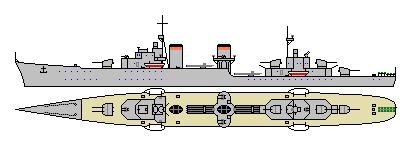The Bhubaneshwar class destroyers have been on the planning table for a couple of years, but kept getting bumped due to other concerns.
The class was added to the books for 1930-31, and incorporated changes already deemed necessary from operational experience. This included the deletion of the torpedo well forward of the bridge, as still seen in the Bassein class, with two quadruple carriages sited amidships. The torpedo armament was to be further doubled with the carrying of a full set of reload weapons. There was also to be an increase in light AA and searchlights, but the main gun armament was to remain at one gun forward and three aft.
This arrangement was finally discredited, after several years of inconclusive internal controversy, by the Filipino Revolution. It was found that a single forward gun was an inadequate armament when destroyers were either attacking or intercepting one; the volume of fire was simply ineffective. Rather than delay the class by re-designing it with a super-firing "Bruno" mount, the gun in "Anton" position was re-designated as a twin mount with much less fuss. The additional top-weight, however, meant that the torpedo reloads had to go.
Two units are planned for 1930, with two more for 1931. It is expected that the follow-up Miraj class of 1932 will be incremental improvements on this class.
Note: L:B ratio is 10.67:1, and the BC as entered is .395, not .40.

Bhubaneshwar, laid down 1930
Length, 112.0 m x Beam, 10.5 m x Depth, 3.8 m
1780 tonnes normal displacement (1582 tonnes standard)
Main battery: 5 x 12.5-cm (1x2, 3x1 DM)
Secondary battery: 6 x 3.5-cm (3x2)
AA battery: 4 x 1.5-cm (1x4)
Weight of broadside: 139 kg
8 TT, 55.0 cm (2x4)
20 t set aside for depth charges + 5 t weight reserve
Hull unarmored
Battery armor:
Main, 3.0 cm shields / secondary, 2.0 cm shields
AA, 2.0 cm shields
Maximum speed for 32502 shaft kw = 34.02 knots
Approximate cruising radius, 7000 nm / 12 knots
Typical complement: 137-178
Estimated cost, $3.644 million (£911,000)
Remarks:
Caution: Hull structure is subject to strain in open-sea
conditions.
Ship has slow, easy roll; a good, steady gun platform.
Magazines and engineering spaces are cramped, with poor
watertight subdivision.
Distribution of weights:
Percent
normal
displacement:
Armament ......................... 38 tonnes = 2 pct
Armor, total ..................... 11 tonnes = 1 pct
Armament 11 tonnes = 1 pct
Machinery ........................ 946 tonnes = 53 pct
Hull and fittings; equipment ..... 499 tonnes = 28 pct
Fuel, ammunition, stores ......... 259 tonnes = 15 pct
Miscellaneous weights ............ 25 tonnes = 1 pct
-----
1780 tonnes = 100 pct
Estimated metacentric height, 0.5 m
Displacement summary:
Light ship: 1520 tonnes
Standard displacement: 1582 tonnes
Normal service: 1780 tonnes
Full load: 1931 tonnes
Loading submergence 636 tonnes/metre
+++++++++++++++++++++++++
Estimated overall survivability and seakeeping ability:
Relative margin of stability: 1.27
Shellfire needed to sink: 182 kg = 6.7 x 12.5-cm shells
(Approximates weight of penetrating
shell hits needed to sink ship,
not counting critical hits)
Torpedoes needed to sink: 0.3
(Approximates number of 'typical'
torpedo hits needed to sink ship)
Relative steadiness as gun platform, 70 percent
(50 percent is 'average')
Relative rocking effect from firing to beam, 0.26
Relative quality as a seaboat: 1.00
+++++++++++++++++++++++++
Hull form characteristics:
Block coefficient: 0.40
Sharpness coefficient: 0.29
Hull speed coefficient 'M' = 9.27
'Natural speed' for length = 19.2 knots
Power going to wave formation
at top speed: 66 percent
Estimated hull characteristics and strength:
Relative underwater volume absorbed by
magazines and engineering spaces: 189 percent
Relative accommodation and working space: 98 percent
Displacement factor: 60 percent
(Displacement relative to loading factors)
Relative cross-sectional hull strength: 0.51
(Structure weight per square
metre of hull surface: 182 kg)
Relative longitudinal hull strength: 1.18
(for 4.40 m average freeboard;
freeboard adjustment +1.13 m)
Relative composite hull strength: 0.56
+++++++++++++++++++++++++
[Machine-readable parameters: Spring Style v. 1.2.1]
367.36 x 34.44 x 12.46; 14.43 -- Dimensions
0.40 -- Block coefficient
1930 -- Year laid down
34.02 / 7000 / 12.00; Oil-fired turbine or equivalent -- Speed / radius / cruise
25 tons -- Miscellaneous weights
++++++++++
5 x 4.92; 0 -- Main battery; turrets
Central positioning of guns
Gun-shields
:
6 x 1.38; 0 -- Secondary battery; turrets
Gun-shields
:
4 x 0.59 -- Tertiary (QF/AA) battery
Gun-shields
:
0 -- No fourth (light) battery
8 / 0 / 21.65 -- TT / submerged / size
++++++++++
0.00 -- No belt armor
0.00 / 0.00 -- Deck / CT
1.18 / 0.79 / 0.79 / 0.00 -- Battery armor
(Note: For portability, values are stored in Anglo-American units)
+++++++++++++++++++++++++++++++++++++++++++++++++++++++

Quoted
On hydrophones: I assume I'd be using whatever's commonly in play. Is everybody setting aside miscellaneous weight for hydrophone weight or what?
